Kiteboarding: Essential Insights for All Levels
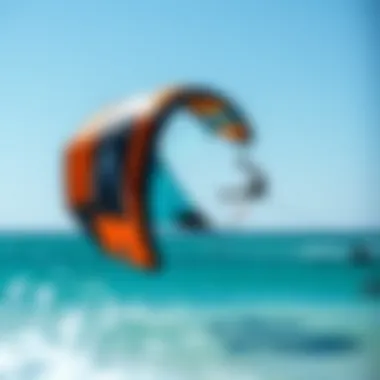
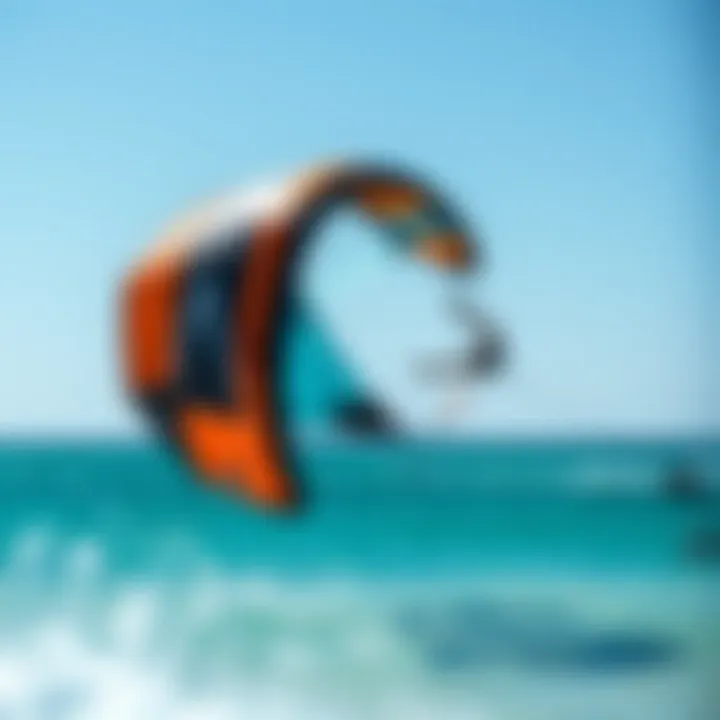
Intro
Kiteboarding, a blend of surfing, windsurfing, and paragliding, stands as one of the most exhilarating water sports feasts. With the wind at your back and the waves beneath your board, there is a certain magic in riding a kite across the open water that captivates both novices and seasoned pros alike. This sport presents an opportunity for adventure and self-expression in ways few other activities can. Whether you're looking to skim along the coast, jump high into the azure sky, or simply enjoy the rush of the wind, kiteboarding has something to offer.
The gear you select can make or break your experience, as having the right equipment means everything. The continual evolution of technology and styles creates a multitude of options, which can be both a blessing and a curse. In this article, we delve deep into all aspects of kiteboarding, encompassing essential gear, skill development tips, and first-rate destinations that cater to kiteboarding enthusiasts. We also hope to shine a light on responsible practices, being mindful of the environment while enjoying this electrifying sport.
So, whether you're just dipping your toes in the waters or are ready to throw down some sick moves at your favorite spot, let’s explore this thrilling world of kiteboarding together.
Gear Selection
Choosing the right gear can often feel like being a kid in a candy store — there are so many options available, yet, navigating through them requires a keen understanding of what suits your style and level. In kiteboarding, two core components stand at the forefront: kites and boards.
Types of Kites
Kites come in various shapes, sizes, and designs, each impacting the performance and feel during a session. Here’s a quick rundown of the main types:
- C Kites: These kites are all about performance and are often preferred by freestylers and experienced riders looking for better control. They provide excellent upwind performance and are generally more powerful but require skill to handle.
- Bow Kites: With a specific design that allows for a wider wind range, bow kites give more stability and ease of use. They are a popular choice for many, especially beginners, as they offer good lift and minimize the chance of crashing.
- Delta Kites: A hybrid of the C and bow styles, delta kites are versatile and provide a good balance between performance and ease of use. They’re suitable for various conditions and level.
Each kite has its unique characteristics, and your choice can depend vastly on the conditions you plan to tackle, your skill level, and, of course, personal preference.
Choosing the Right Board
Alongside your kite, the board is another key player in your kiteboarding experience. The choice here typically falls between twin-tips and directional boards.
- Twin-Tip Boards: These are the most popular and widely used. They can be ridden in either direction, making it easy to switch during a session.
- Directional Boards: Usually resembling surfboards, they’re made for riding waves or for specific styles like freestyle. They offer a different feel on the water and can enhance the riding experience.
Selecting the appropriate size is also crucial, as it directly influences your foundation on the water. Lighter riders may find smaller boards easier to maneuver, while heavier riders might prefer larger boards for stability.
In a nutshell, gear selection is about synergy between personal skill and environmental conditions. Your goal depends upon what type of experience you want; whether that's to push your limits, cruise calmly, or ride waves while carving through water.
"Investing in quality gear helps enhance both safety and enjoyment, allowing a seamless experience on the waves."
Picking your tools wisely is the first step to unlocking the thrills of kiteboarding. With the right equipment, the world becomes your playground.
Stay tuned for the following sections, where we’ll dive into skill development, traverse essential techniques, and share tips to help newcomers progress smoothly.
Understanding Kiteboarding
Kiteboarding blends elements of surfing, windsurfing, and paragliding into a thrilling sport that captures the essence of water and air. This section serves as a gateway into the fascinating world of kiteboarding, shedding light on its significance in the lives of countless enthusiasts around the globe. The main purpose here is to underline how understanding the fundamentals can not only elevate one's performance but also enhance the overall enjoyment of the sport.
By comprehending the nuances of kiteboarding—ranging from the mechanics of the gear to the environmental influences—participants can engage in the sport with increased safety and competence. For instance, knowing how to read wind patterns and recognizing the importance of equipment setup are vital skills that can make or break a session on the water. There’s a sense of empowerment when kiteboarders can navigate through challenges calmly, enhancing both their skill set and emotional connection to the sport.
Though it may seem straightforward, kiteboarding is a discipline that demands respect, practice, and ongoing learning. It’s about embracing the wind, mastering the language of the waves, and developing a deeper appreciation for the natural world.
"Kiteboarding is not just a sport; it’s a dance with nature. The more you understand it, the better you perform."
In this exploration, various components such as the origins, comparative analysis with other water sports, and essential skills will unfold to reveal kiteboarding’s depth. Every piece of knowledge adds value to your kiteboarding journey, ensuring that whether you're a newcomer or a seasoned rider, there’s always something new to learn and experience. Therefore, let’s dive right into the rich history of this exhilarating activity.
The Origins of Kiteboarding
Kiteboarding traces back several centuries, birthing from the traditional kiting practices seen in cultures worldwide. Although the usage of kites for recreation can be traced back to ancient China, the modern form of kiteboarding really took shape in the late 20th century. During the 1970s, inventors began experimenting with various designs, combining surfing with kites. The pivotal moment came in the late 1990s when enthusiasts like Bruno and Dominique Legaignoux developed the first inflatable kite, revolutionizing the sport.
From these humble beginnings, kiteboarding gained momentum rapidly. People began flocking to beaches, sharing tips and experiences, turning kiteboarding into a collective movement rather than just an isolated interest. Kiteboarding's popularity has been partly shaped by the stunning visuals of riders gliding over the water, combined with tales of adventure. The sport has expanded globally, now being practiced on diverse waters ranging from tropical paradises to icy lakes.
Kiteboarding vs. Other Water Sports
Kiteboarding stands out in the realm of water sports due to its unique blend of adrenaline and artistry. Unlike traditional surfing, which relies solely on waves, kiteboarding harnesses the power of the wind, allowing for diverse riding styles and tricks. The flexibility of kiteboarding enables enthusiasts to practice on different water bodies, whether it's oceans, lakes, or rivers.
In comparison to windsurfing, kiteboarding offers greater ease of mobility. Riders can traverse large distances without battling heavy equipment, which is often a painstaking task in windsurfing. Moreover, kiteboarding provides more opportunities for aerial maneuvers, allowing riders to perform gravity-defying tricks, which can be seen as a major draw for thrill-seekers.
Nevertheless, each water sport has its distinct appeal and community, and choices often come down to personal preference. Whether one opts for the waves or the wind, there’s a shared love and respect for the water that binds these activities together.
With a basic understanding of kiteboarding laid out, it's time to gear up and delve into the vital equipment that makes this sport what it is, ensuring safety and performance at every turn.
Essential Gear for Kiteboarding
When diving into the exhilarating world of kiteboarding, understanding the essential gear is key. This equipment isn’t just a collection of accessories; it forms the backbone of your experience on the water. The right selection can enhance performance and ensure safety—two crucial elements in a sport that thrives on both thrill and technique. Without the appropriate gear, you risk both the enjoyment of the sport and your personal safety. In kiteboarding, the gear choice can mean the difference between a good day on the water and a regrettable mishap.
Types of Kites
Kites are the heart and soul of kiteboarding. They come in numerous shapes and sizes, designed for various weather conditions and rider preferences. Broadly, there are two main types: inflatable kites and foil kites.
- Inflatable kites are the most commonly used in kiteboarding. They provide a stable platform and are easy to handle, making them ideal for beginners and those in moderate to strong winds. Their ability to maintain shape when inflated gives them excellent lift and power.
- Foil kites, on the other hand, have no rigid structure and rely on air to maintain their shape. This makes them lighter and more efficient. They're suitable for light wind conditions but might require more skill and experience to handle effectively.
Ultimately, choosing the right kite comes down to your skill level, the conditions, and your specific riding style, whether you prefer speed, agility, or tricks.
Choosing the Right Board
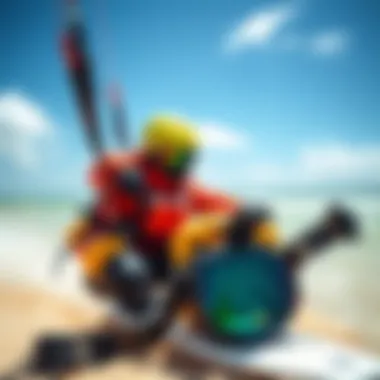
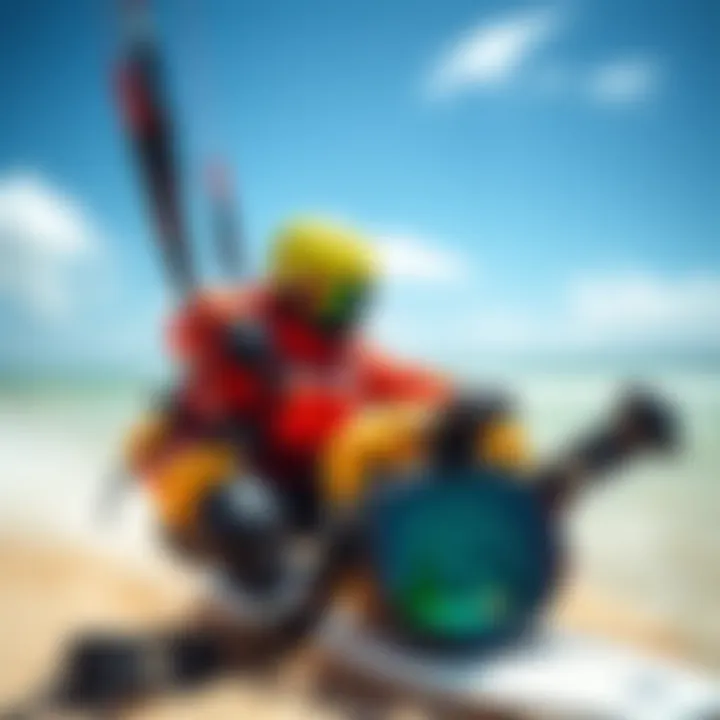
Selecting the appropriate board for kiteboarding is a fundamental step to enhance your overall performance. Each board is designed with particular shapes and materials that affect speed, stability, and control in water.
Different Board Shapes
The shape of the board significantly impacts how it rides through the water. Here are some considerations:
- Directional boards are often used for wave riding. They resemble surfboards and allow for seamless maneuverability. A well-designed directional board can give you precision and speed in rough conditions.
- Twin-tip boards, which are symmetrical, provide versatility since they can be ridden in both directions. This characteristic makes them popular among beginners and freestyle riders.
Key characteristics of board shapes include tail design, rocker profile, and width. These elements all contribute to how the board performs, affecting things like speed and jumping capability. For instance, a wider board can offer better stability, particularly for beginners, while a narrow board can slice through water, providing speed and responsiveness in the air.
Material Considerations
The material of the kiteboard also plays a crucial role in performance. Most kiteboards are made from materials like fiberglass, carbon fiber, and foam. Here's how they stack up:
- Fiberglass boards offer a good balance of flexibility and durability, making them a great choice for all-around kiteboarding.
- Carbon fiber boards are lighter and stiffer than fiberglass. They provide excellent acceleration and responsiveness but can come at a higher price point.
- Foam-core boards are often used for their buoyancy and lighter weight, which makes them well-suited for beginners and those learning tricks.
Each material has distinct advantages and disadvantages, including weight, durability, and cost. It’s critical to choose one that aligns with your skill level and riding ambitions.
Safety Equipment
Safety gear is non-negotiable in kiteboarding. Just like a seatbelt in a car, proper equipment ensures that you're prepared for the unexpected, mitigating risks associated with this dynamic sport.
Harnesses
Harnesses connect you to the kite and distribute the pull across your body, reducing strain. There are two main types of harnesses: seat harnesses and waist harnesses.
- Seat harnesses provide more support and are generally better for beginners as they help keep you positioned correctly while riding.
- Waist harnesses, however, offer more mobility and are preferred by advanced riders seeking higher jumps and tricks.
Each type has its own unique advantages in terms of comfort, stability, and ease of use.
Helmets
While kiteboarding can seem like a carefree adventure, many injuries occur due to falls or collisions. Wearing a helmet is crucial for protection. A good helmet can safeguard your head from impacts, especially during tricks and jumps. Many modern helmets also come with additional features, like ear protection and visors, which can offer further benefits without compromising comfort.
Impact Vests
An often-overlooked piece of equipment is the impact vest, which helps protect your torso during crashes. Unlike life jackets, impact vests are designed specifically for kiteboarding, providing a snug fit that allows for freedom of movement while cushioning your body from hard landings or choppy waters.
Mastering Kiteboarding Techniques
Understanding the various techniques in kiteboarding is essential for both safety and enjoyment. This sport requires a blend of skills that evolve from basic abilities to more advanced maneuvers. Mastery in kiteboarding opens up a world of possibilities, allowing riders to perform tricks and navigate challenging conditions effectively. Mastering these techniques not only enhances the excitement of the sport but also fosters a greater appreciation for the wind, water, and the overall kiteboarding experience.
Fundamental Skills for Beginners
Launching and Landing
Launching and landing a kite can make the difference between a smooth ride and a challenging day at the beach. Proper launching is crucial as it initiates your kiteboarding journey each time you hit the water. The primary characteristic of launching is understanding the wind direction and controlling the kite’s position.
Beginners should practice launching in steady wind conditions, ideally with an experienced partner close by. This is particularly beneficial as the right technique keeps the kite stable overhead and helps avoid unexpected power surges. If not executed properly, a launch can easily lead to crashes or equipment damage, affecting your confidence and enjoyment.
Some unique features of launching technique involve the angle at which you pull the kite as well as your body position. Balancing the kite’s power against your body weight can be tricky but vital. Overall, mastering launching sets the stage for further skills in kiteboarding.
Water Starts
Once you've got the kite in the air, the next step is getting up, which involves the water start. This technique enables you to stand up on your board and ride away smoothly from a still position in the water. It requires a blend of balance, timing, and kite control.
A remarkable characteristic of water starts is that they involve both the kite's pull and your body’s position. Successful water starts hinge on keeping the board at the right angle while allowing the kite to generate power without overpowering the rider. Many find this technique both exhilarating and challenging, making it a popular focal point for learning.
Water starts do have their nuances. For example, assessing the right beach location for launching can play a significant role, especially for beginners. If conditions are too chaotic, getting up can become daunting. So, picking the right spot and perfecting this technique enhances your entire kiteboarding experience.
Advanced Maneuvers
Tricks and Jumps
As one advances in kiteboarding, tricks and jumps become not just goals but also a way to express individuality on the water. These maneuvers combine skill, creativity, and a solid understanding of kite control. The fundamental aspect of tricks and jumps is timing; the proper rhythm can facilitate transitions into airborne feats.
Tricks are popular because they not only display one’s progression in the sport, but they also provide a sense of accomplishment. From simple jumps to complex spins, the variety is vast, helping riders push their limits and creativity. Practicing these maneuvers often leads to notable boost in self-confidence.
However, tricks come with their own risks and challenges. If attempted without sufficient control or awareness of surroundings, they can become hazardous. So, it’s vital to progress incrementally and ensure a solid base of skills.
Riding Upwind
Mastering the upwind riding technique is among the most rewarding skills in kiteboarding. It allows riders to traverse across the water efficiently, effectively against the wind. The key feature of riding upwind lies in the positioning of the kite and the sharpness of the turns performed on the board.
Many view riding upwind as a rite of passage within the kiteboarding community since it opens doors to new locations and riding experiences. The ability to move against the wind enables kiteboarders to explore different spots without constantly having to walk back.
On the downside, upwind riding can be physically demanding. Proper technique is essential, as failure to ride effectively leads to excessive energy expenditure. Nonetheless, once mastered, it is a skill that significantly enhances a kiteboarder’s overall proficiency, allowing them to venture further and enjoy a more comprehensive range of the sport.


"Mastering these techniques not only enhances the excitement of the sport but also fosters a greater appreciation for the wind, water, and the overall kiteboarding experience."
For added resources, enthusiasts can visit Wikipedia for more in-depth history and techniques, or check out discussions on platforms like Reddit to engage with other kiteboarders.
Thus, moving from fundamental skills to advanced maneuvers provides a broad spectrum of experiences and growth opportunities in kiteboarding, solidifying one’s journey in this exhilarating water sport.
Safety Protocols in Kiteboarding
Safety is paramount when engaging in kiteboarding. This sport, characterized by its exhilarating mix of speed and artistry, also holds inherent risks. Adhering to strict safety protocols is not just a guideline; it’s a necessity for both novice and experienced riders. Understanding safety measures can not only enhance one’s enjoyment but also prevent incidents that could lead to serious injuries or equipment damage.
Understanding Weather Conditions
Weather dictates the functionality and safety of kiteboarding. A clear grasp of the weather can mean the difference between a thrilling session and a dangerous one. Understanding wind strength and the associated waves and currents plays a critical role in ensuring a safe kiteboarding experience.
Assessing Wind Strength
Assessing wind strength is one of the foremost considerations for kiteboarders. It informs the choice of equipment and the suitability of conditions for riding. Wind is categorized generally into four ranges: light, moderate, strong, and gusty.
- Light winds (under 10 knots): Suitable for beginners, as they allow for comfortable learning conditions but may limit performance.
- Moderate winds (10-20 knots): Ideal for most boarders. Here, riders can explore a balance of control and speed.
- Strong winds (20-30 knots): More experienced riders can thrive, however, it greatly increases risk. Control can become a challenge.
A unique feature of assessing wind strength includes the ability to read the wind patterns across the water. Familiarity with this knowledge allows riders to anticipate changes in wind pressure, ensuring they can adjust their strategies accordingly. However, it can be tricky; misunderstandings in assessing wind strength can lead to dangerous conditions, especially if one underestimates gusts.
Waves and Currents
Waves and currents are additional components that kiteboarders must consider. They can affect both the riding experience and safety. Waves can vary from small and rippling to large and powerful, impacting how one rides.
- Small waves: Ease the learning process, providing a smoother ride.
- Larger waves: Pose more of a challenge, requiring skill to navigate safely.
Currents play a vital role as well. Understanding local current patterns can prevent drifting and keeping riders within safe zones. A significant aspect of this is recognizing how a current can assist or hinder a kiteboarder’s maneuverability. Cooperation between wind and waves is essential in the assessment of conditions. This comprehension is important to mitigate the risk of injury or negative experiences on the water.
Rescue Procedures
Despite the best preparations, accidents can occur in kiteboarding. Knowing rescue procedures is critical for all participants.
- Buddy System: Always ride with a friend in case of emergencies. They can react quicker and provide necessary help.
- Self-rescue Techniques: Riders should practice ways to regain control after losing their kite. For instance, learning to turn the board to use as a flotation device comes in handy when separated from equipment in the water.
- Signaling for Help: Awareness of how to signal other riders or boaters can provide essential support during dire circumstances.
Remember, preparation is key! The more informed you are about safety procedures, the smoother your kiteboarding experience will be.
Emphasizing these safety protocols fosters a better relationship between the sport and its environment, ultimately allowing enthusiasts to enjoy kiteboarding while minimizing the risks involved. Continual learning and adherence to safety measures will lead to a much more rewarding experience on the water.
Exploring Kiteboarding Destinations
Exploring kiteboarding destinations is not just about finding the right spot to catch some wind; it’s about immersing oneself in the culture, meeting fellow enthusiasts, and experiencing the thrill of riding in diverse environments. The locations chosen for kiteboarding can significantly influence one’s skills, enjoyment, and overall experience. Different venues present unique challenges and rewards, from the strength of the wind to the variety of water conditions.
When looking at destinations, it's crucial to consider several factors:
- Wind Consistency: Locations known for steady winds usually offer better conditions for both beginners and seasoned riders.
- Best Season: Understanding the ideal months for each destination helps ensure a successful trip. For instance, summer might be peak season in one area while winter is prime in another.
- Local Community: Places with strong kiteboarding communities provide opportunities for learning and networking. Having access to lessons, gear rentals, and local events can elevate any kiteboarder's adventure.
Choosing the right spot also enhances one's connection to nature. With sustainability in mind, it's important to engage responsibly with each environment. Kiteboarding can impact marine ecosystems, so finding locations that promote eco-friendly practices is crucial.
Quote: "The destination isn't just the backdrop; it’s an integral part of the kiteboarding experience. The right location can transform a good session into an unforgettable one."
Top Global Spots for Kiteboarding
When discussing top global spots for kiteboarding, it’s essential to recognize a blend of natural beauty, consistent winds, and beginner-friendly conditions alongside advanced challenges. Some notable mentions include:
- Cabarete, Dominican Republic: Often hailed as a kiteboarding mecca, vibrant Cabarete is known for its reliable trade winds and lively atmosphere. Ideal from December to April, this beach town attracts riders of all levels.
- Cumbuco, Brazil: Known for its warm water and phenomenal wind conditions, Cumbuco offers a stunning landscape combined with a laid-back vibe. The season runs from June to January, making it a paradise during winter months.
- Langebaan, South Africa: Located near Cape Town, Langebaan boasts a unique lagoon with flat waters that are perfect for beginners while offering wave spots for the more experienced. The South African summer ensures thrilling conditions between November and March.
- Tarifa, Spain: Often referred to as the wind capital of Europe, Tarifa has two seas meeting, resulting in steady winds and excellent conditions. The summer months pull in enthusiasts from all over, making it a lively kiteboarding hub.
Local Gems Worth Discovering
Beyond the popular global hotspots, local gems present opportunities for incredible kiteboarding away from the crowds. Each has its unique charm:
- Kent, England: Offering enchanting scenery and windy conditions at spots like Camber Sands, Kent appeals to those who prefer a quieter experience. Summer months are especially good here, with a strong kiteboarding community supporting newcomers.
- Pozo Izquierdo, Gran Canaria: This hidden gem features powerful winds and is well-regarded for wave riding. Though it attracts advanced riders, the breathtaking views and local culture make it a must-visit.
- Maui, Hawaii: While Maui is often associated with many water activities, its kiteboarding locations are lesser-known. The stunning beaches and perfect wind conditions promote a one-of-a-kind riding experience that shouldn’t be overlooked.
- Hood River, Oregon: Nestled in the Columbia River Gorge, Hood River offers a distinctive blend of mountain scenery and water conditions. The season runs from May to September, making it a beautiful summer getaway for riders of all skill levels.
In short, whether considering well-known destinations or discovering intimate, lesser-visited spots, the world of kiteboarding is vast and varied. Understanding where to go not only enhances one’s skill set but also fosters a greater appreciation for diverse ecosystems across the globe.
Environmental Considerations in Kiteboarding
Kiteboarding, while thrilling and invigorating, comes entwined with significant environmental matters. As kiteboarders, it’s vital to recognize the delicate balance between enjoying the open seas and respecting the marine habitats that sustain wildlife. This section delves into how our beloved sport intersects with marine conservation, underlining the necessity to practice responsible kiteboarding.
Impact of Kiteboarding on Marine Ecosystems
When we think of kiteboarding, the image of soaring kites and speeding boards comes to mind. Yet, the act of gliding over the water isn’t without its consequences to marine life. These effects can be subtle or overt, depending on the area and the local ecosystem. Some creatures, particularly nesting sea turtles and delicate coral reefs, can be disrupted by the presence of kiteboarders.
- Disturbance to Wildlife: Kiteboarders often venture close to shores where various species flourish. The noise produced by kiteboarding can startle animals, especially during their breeding seasons. Birds, for instance, may abandon nests if they feel threatened.
- Erosion Issues: The frequency of foot traffic on sandy beaches, popular launching zones, can lead to erosion, changing the coastal landscape over time. When the natural patterns are disrupted, this can have knock-on effects for wildlife that depend on these habitats.
- Water Quality: Pumping kites, boards, and other equipment can inadvertently release pollutants into the water. This not only affects the sport itself but can compromise the health of marine ecosystems.
"Every action you take while kiteboarding can ripple through the environment, impacting marine life in ways you might not immediately see."
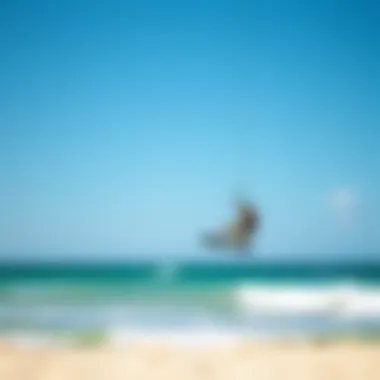
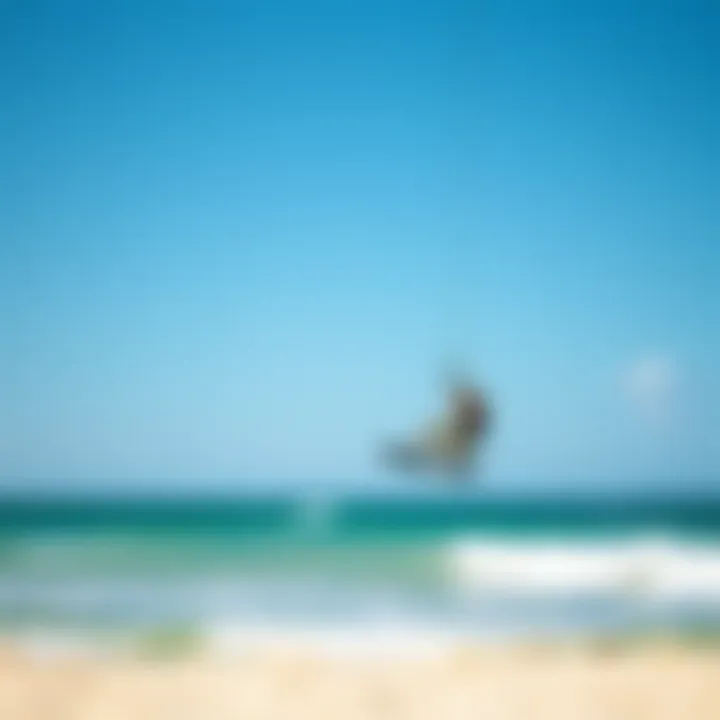
Promoting Sustainable Practices
So, how do we as kiteboarders ensure that our passion doesn’t come at the expense of our blue planet? Here are a few mindful practices to integrate into your kiteboarding routine.
- Respect Restricted Areas: Always be aware of local regulations regarding protected zones. Avoid launching or landing kites in areas prohibiting access to certain wildlife habitats.
- Gear Up Responsibly: Opt for eco-friendly gear whenever possible. Some companies are beginning to produce equipment using sustainable materials and practices. Supporting these brands can help steer the market towards greener options.
- Leave No Trace: Clean up after every session. Whether it’s trash or broken gear, ensuring you take your belongings with you is crucial. This small act can go a long way in preserving the beauty of your favorite kiteboarding spots.
- Educate and Advocate: Share knowledge about the importance of marine conservation with fellow kiteboarders. Organize or partake in clean-up events at local beaches to foster a community-wide initiative towards environmental stewardship.
By incorporating sustainable practices, kiteboarders not only enhance their own experiences but also ensure that the joy of kiteboarding can be passed down through generations. The balance between thrill and respect for the natural world is key in creating a sustainable environment for all.
The Kiteboarding Community
The kiteboarding community serves as the backbone of this thrilling sport. It is not just about the individual experience on the water but about the connections forged among enthusiasts, instructors, and event organizers. The shared passion for kiteboarding fosters a sense of belonging and camaraderie, creating a network where individuals can learn, share experiences, and grow in their skills.
Engaging with the community allows kiteboarders to navigate challenges more effectively. It’s often said that "you can’t soar like an eagle if you hang out with turkeys." Here, the implication is clear - surrounding oneself with motivated and knowledgeable individuals can elevate one's own proficiency in kiteboarding.
Additionally, local kiteboarding clubs offer a welcoming atmosphere for newcomers. They provide mentorship opportunities, lessons, and social gatherings where individuals can bond over their love for the sport. The benefits of joining these communities can’t be overstated. Not only can members receive guidance from more experienced kiteboarders, but they can also find inspiration in others' successes.
Connecting with Fellow Enthusiasts
Finding a tribe in kiteboarding is essential for both learning and enjoyment. When you connect with fellow enthusiasts, you get access to valuable insights, tips, and advice that can dramatically enhance your skills. Online platforms and forums, such as Reddit or Facebook groups, are excellent channels for initiating these connections.
- Networking Opportunities: Engage with participants in local kiteboarding events or festivals to spark connections.
- Learning from Each Other: Many riders share experiences and techniques, which can fast-track your learning curve.
- Buddy System: Pairing up with someone helps improve safety and creates companionship during sessions.
It’s crucial to remember that kiteboarding can be challenging and sometimes intimidating for beginners. The friendly gestures and encouragement from community members evoke a welcoming environment. Many enthusiasts are happy to pass on their knowledge, resulting in a rich exchange of learning experiences.
Events and Competitions
Events and competitions in kiteboarding serve as pivotal moments for community building. They bring together kiteboarders from varied backgrounds and skill levels, creating an electrifying atmosphere.
- Local Competitions: These events are a great starting point for inexperienced riders wishing to step into the competitive arena. Participating in local competitions offers anyone a chance to see how their skills measure up while also connecting with local talent.
- International Festivals: From the Kiteboard Tour Asia to the Red Bull Kiteboarding World Cup, these events not just create a competitive spirit but also foster international camaraderie.
- Workshops and Demos: These occasions often feature professional kiteboarders who provide demonstrations and workshops, allowing enthusiasts to learn firsthand from the best in the field.
Important Note: Engaging in such events can lead to new friendships, exposure to innovative techniques, and even future opportunities in the kiteboarding world.
Moreover, attending these gatherings sparks excitement and motivation in participants. Witnessing skilled athletes perform breathtaking tricks can reignite one's passion for the sport. The underlying theme in these events is not only about competition but also about connection and shared love for kiteboarding.
Staying Updated on Trends
In a sport as dynamic as kiteboarding, being in tune with the latest trends is not merely advantageous; it is essential. Staying updated allows riders to make informed choices about gear, techniques, and even safety protocols. In a world where technology is advancing at breakneck speed, those who adapt and innovate often find themselves at the forefront of this exciting water sport.
Emerging Technologies in Equipment
Technology has seeped into every corner of kiteboarding, revolutionizing how enthusiasts approach the sport. From kites to boards, innovations are reshaping the landscape.
- Smart Kites: Some manufacturers are experimenting with smart kites that incorporate sensors. These kites can provide feedback on wind conditions directly to the rider, allowing for adjustments on-the-fly. Imagine knowing the optimal angle for your jumps or how to best align your body with the wind—these insights can take your performance to new heights.
- Material Advancements: The materials used in kite construction have also advanced significantly. For example, Dyneema lines promise durability while being extremely lightweight. This means easier handling and potentially better performance, as every ounce of weight matters.
- Inflatable Innovations: Recent developments in inflatable designs have led to kites that are not just more robust but also more streamlined. This contributes to a smoother ride and increased responsiveness in diverse wind conditions.
Such technological advancements cater to different skill levels, encouraging both novices and seasoned riders to push their boundaries. Keeping abreast of these trends doesn’t just enhance performance; it can also play a role in fostering safer riding environments.
Innovative Riding Techniques
While equipment plays a crucial role, the techniques one employs on the water are equally important. New riding styles and methods are continually emerging, transforming the way kiteboarders approach their time on the water.
- Freestyle Progression: Riders are constantly inventing and perfecting new tricks. Keeping up with tutorials via online platforms can aid in mastering these moves. Be it a new spin or slide, videos from seasoned riders can show the nuances that make all the difference.
- Foil Riding: This technique has gained traction, allowing riders to glide above the water on a hydrofoil board. It’s an exhilarating experience—almost like flying. Staying updated on the intricacies of foil riding could open up a new dimension of kiteboarding, bringing exhilaration and a chance to enjoy the sport in lighter winds as well.
- Wave Riding: As kiteboarding blends with wave surfing, understanding different wave riding techniques can significantly change your experience. Knowledge about reading waves and using them to your advantage can lead to thrilling sessions.
Keeping abreast of innovative riding techniques not only propagates better skills but also cultivates a culture of sharing knowledge within the kiteboarding community.
"Knowledge is power in kiteboarding. Those who seek to stay informed reap not just rewards in skill but also in safety and innovation."
The End
In wrapping up our exploration of kiteboarding, it's crucial to take a moment to reflect on the various threads that weave together the intricacies of this exhilarating sport. Kiteboarding isn't simply about gliding across the surface of the water with the wind in your hair; it’s a holistic experience that merges physical skill, mental fortitude, and a bond with nature.
Reflecting on the Journey of Kiteboarding
Kiteboarding first emerged as a distinct sport back in the late 1980s, evolving from experiments with kites and boards into the mainstream activity that captivates so many today. For many, the journey begins with a sense of freedom, as the thrill of harnessing nature's power resonates deeply. Each session on the water is not just practice; it’s a chapter in a story of personal growth and adventure.
Reflecting on one's own progression in kiteboarding can foster a sense of accomplishment. Whether you’re nailing your first jump or mastering complex tricks, every milestone serves as a reminder of the dedication required. For instance, the very first water start often fills novices with a mix of excitement and fear. But overcoming that hurdle sets the stage for a continued love affair with the ocean and the wind.
People often recount their first experiences like tales of old, sharing laughs about falls and victories alike. The connection to the kiteboarding community—with its camaraderie, shared experiences, and passionate discussions—adds another vital layer to this journey. Participating in events, helping fellow enthusiasts, and exchanging tips creates a bond that goes beyond the individual, making kiteboarding a collective endeavor.
Encouraging Lifelong Learning and Passion
As with any skill, longevity in kiteboarding correlates directly with a commitment to ongoing education. The waters and winds may change, and so too will the equipment. Staying updated on gear innovations, techniques, and safety protocols is paramount. Joining workshops, participating in clinics, or simply sharing knowledge with more experienced riders can enrich one’s expertise and enjoyment of the sport.
Embracing a mindset of lifelong learning can open countless doors. Committing to mastering new tricks or expanding one’s knowledge about prevailing weather conditions can fundamentally enhance your time on the water. This passion to keep learning not only sharpens individual skills but also revives enthusiasm, much like the first rush of wind in a novice’s sails.
Additionally, engaging with new riders can be incredibly fulfilling. Mentoring someone through their initial stages can spark the same excitement felt back in your own learning days. This cycle of learning and teaching keeps the spirit of kiteboarding alive and vibrant.
Ultimately, kiteboarding serves as a gateway to adventure and personal discovery. Embracing all aspects of the sport cultivates a deeper connection with both the community and nature itself. It’s an ongoing journey, shaping lives in surprising and meaningful ways.
"The real joy of kiteboarding is not just in the ride but in the journey it offers. Each sail through the wind is a story waiting to be told."
Further Resources
- For comprehensive guides on techniques and safety, visit Kiteboarding.com.
- Connect with fellow enthusiasts on Reddit Kiteboarding.
- Learn about environmental impacts and sustainable practices on sites like Britannica.
- Dive deeper into the history and evolution of kiteboarding at Wikipedia.
The adventure of kiteboarding continues, and as you stand on the shore or glide across the water, remember the importance of both learning and enjoying every moment ahead.















